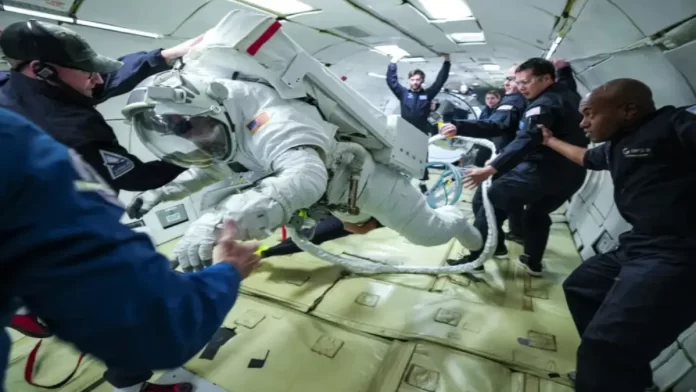Houston, Texas: In a significant stride towards enhancing space exploration capabilities, Collins Aerospace recently achieved a pivotal milestone in collaboration with NASA, marking a crucial advancement in the development of a next-generation spacesuit destined for use aboard the International Space Station (ISS).
The milestone, characterized by a pressure garment system fit and functionality test conducted in a microgravity-like environment, represents a critical juncture in the journey towards creating a cutting-edge suit tailored for NASA’s ongoing operations and scientific endeavors in low Earth orbit.
NASA’s selection of Collins Aerospace for the development of this innovative spacesuit signifies a transformative shift in space station attire. This new suit, slated to replace the current extravehicular mobility unit worn by astronauts for over two decades, is poised to redefine spacewalking capabilities and facilitate the assembly and maintenance of the ISS with unprecedented efficiency.
The recent Collins test, conducted aboard a commercial microgravity aircraft, provided invaluable insights into the suit’s performance under simulated weightless conditions. Through a series of parabolic flight maneuvers, engineers, scientists, and students were able to evaluate the suit’s functionality in a space-like gravity environment, offering a glimpse into its operational prowess without the need for actual space travel.
This milestone represents a crucial phase in NASA’s preliminary design review process, a stringent evaluation ensuring that the suit meets all system requirements before proceeding to the manufacturing phase of flight-ready units.
Moving forward, Collins Aerospace will continue to rigorously test its spacesuit in various environments, including a vacuum chamber to simulate space-like conditions, as well as at NASA’s Neutral Buoyancy Laboratory in Houston. These tests aim to validate the suit’s performance in real-world scenarios, setting the stage for its integration into NASA’s spacewalking endeavors.
Designed to elevate NASA’s spacewalking capabilities in low Earth orbit, this next-generation spacesuit is poised to revolutionize station maintenance and operations. With a steadfast commitment to advancing scientific research and technological innovation, NASA and its international partners are poised to unlock new frontiers in space exploration, paving the way for humanity’s continued journey beyond Earth’s boundaries.
Intake of this News
- Milestone Completion: Collins Aerospace achieved a significant milestone in the development of a next-generation spacesuit for NASA’s use on the International Space Station (ISS).
- Test Details: The milestone involved a pressure garment system fit and functionality test in a microgravity-like environment, a crucial step towards ensuring the suit’s suitability for space operations.
- Purpose of the Spacesuit: NASA selected Collins Aerospace to develop a new spacesuit to replace the current extravehicular mobility unit worn by astronauts on the ISS for over two decades. This new suit aims to enhance spacewalking capabilities and support station maintenance and operations.
- Testing Process: The test was conducted aboard a commercial microgravity aircraft, providing brief periods of weightlessness to simulate space conditions. Further testing will be conducted in a vacuum chamber and at NASA’s Neutral Buoyancy Laboratory to evaluate the suit’s performance in space-like environments.
- Design Review Process: The milestone represents a key step in NASA’s preliminary design review process, ensuring that the suit meets all system requirements before proceeding to manufacturing.
- Future Implications: The next-generation spacesuit is designed to advance NASA’s spacewalking capabilities in low Earth orbit and support ongoing scientific research conducted on the ISS. It also aims to demonstrate new technologies for future human and robotic missions.
- Collaborative Efforts: Collins Aerospace and NASA are working closely together to develop and test the new spacesuit, highlighting the importance of collaboration in advancing space exploration.
- Continued Progress: Further updates are expected as testing and development of the spacesuit progress, with the ultimate goal of enhancing humanity’s ability to explore and operate in space.



